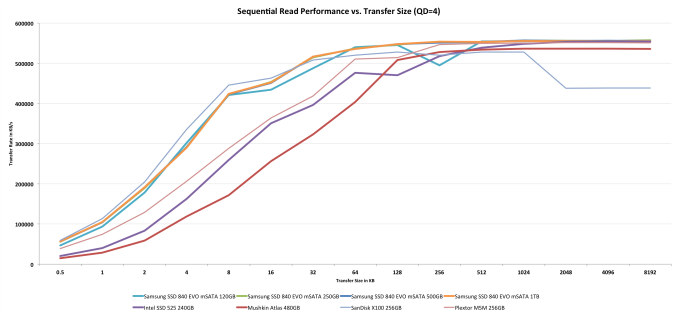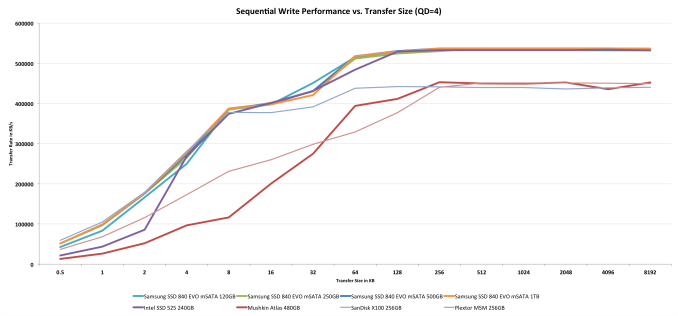Samsung SSD 840 EVO mSATA (120GB, 250GB, 500GB & 1TB) Review
by Kristian Vättö on January 9, 2014 1:35 PM ESTPerformance vs. Transfer Size
ATTO is a useful tool for quickly benchmarking performance across various transfer sizes. You can get the complete data set in Bench. The EVO mSATA is top of the class at all transfer sizes. Even though we're dealing with highly compressible data, which is the strength of SandForce, the EVO mSATA turns out to be slightly faster than the Intel SSD 525. Keep in mind that these tests are with an empty drive so TurboWrite plays a massive role and since the test only writes 2GB, all EVO mSATAs perform similarly regardless of the capacity.
Click for full size












65 Comments
View All Comments
Brenderick - Saturday, February 15, 2014 - link
mSata was what the commenter wanted.MoFoQ - Friday, January 10, 2014 - link
same hardware?The mSATA version has 4 NAND packages.
The 2.5" version has 8.
Sure, the number of dies total might be the same.
It's like comparing two houses of the same square-footage....except one of them is a two-story house and the other, a single-story one.
With that said, it is an interesting development for mSATA SSDs.
I can't wait until other manufacturers come to market to help drive the price down.
emvonline - Friday, January 10, 2014 - link
16 die packages are possible at all NAND suppliers and it is relatively straight forward to implement. the issue is usually that there is minimal demand for anything requiring it. What percentage of the market is 1TB? I think we are talking less than 3% above 512G for consumers. let me know if I am wrong.TLC is great for Samsung product margins. so far it hasn't led to a cost decrease for consumers.
Samsung's execution is the amazing part. they have good (or great) products in every market at every density. And they have the most aggressive marketing campaign. No one else has been able to achieve this.
Marrixster - Saturday, January 11, 2014 - link
Thanks very much indeed for this review. I already have 2 Samsung PM851 512GB (MZMTE512HMHP-00000). And, just prior to reading this review ordered the 1TB model (MZ-MTE1T0BW).The price is AUD822.99 (ramcity.com.au), very expensive. However, the convenience of this form factor justifies cost from my point of view.
Now, it's simply a matter of deciding which lappy it gets installed in.
Unit Igor - Saturday, January 11, 2014 - link
Tell me Kristian please would EVO 120GB msata have any advantage over EVO 250gb msata in longer battery life when you compare power consumption vs. disk busy times and mb/s.I use my ultrabook only for mails ,sometimes watching movies and surfing.I dont need more then 120GB SSD but i am willing to buy 250Gb if it would give me more battery life.What i wanted to see in your benchmark is MobileMark 2012 because msata is for laptops and that is where battery life play big role.philipma1957 - Sunday, January 12, 2014 - link
the new gigabyte brix with the i7 4770r cpu 16th ram and a 1tb mSata would be really nice gear.nogoms - Monday, January 13, 2014 - link
You start off with the claim that "Samsung is in a unique position in the SSD market. It’s the only company in the consumer SSD business with a fully vertically integrated business model and zero reliance on other companies."This is, however, not actually true. SK Hynix is in a similar position, as they've had their own controllers, NAND, and DRAM since their purchase of LAMD a year and a half ago. Admittedly, they hadn't actually released a completely in-house SSD using a LAMD controller until late last year with the release of the SH 920 series. In fact, the Surface Pro 2 uses an SK Hynix mSATA SSD (with a LAMD controller), as noted in Anand's review and iFixIt's teardown. SK Hynix also doesn't appear to be making the SH920 series available in retail outside of Asia, though Super Talent's Supernova3 series is available in retail in North America (from the likes of SuperBiiz and various third-party sellers on Amazon and Newegg) and appears to be rebranded 2.5" SK Hynix SH920 series drives.
Kristian Vättö - Monday, January 13, 2014 - link
I did mention SK Hynix and LAMD later in the article:"Sure, Samsung isn't the only NAND manufacturer but it is the only one with a consumer orientated controller IP (although SK Hynix owns LAMD now but that deal has yet to materialize in a product)"
The thing is, while Hynix does have a LAMD based SSD, it's the same controller that other's are using. It's possible that Hynix has contributed to the firmware but it's not a fully in-house designed platform (the controller was designed way before the acquisition took place).
nogoms - Monday, January 13, 2014 - link
That statement is also false, as SK Hynix's LAMD controller *has* materialized in products, as I pointed out in my previous post--they're available in complete systems like the Surface Pro 2 worldwide as well as standalone at retail (in East Asia). Also, it's disingenuous to say it's not fully in-house when the controller and firmware were designed and written by teams currently in the employ of SK Hynix, and even if one were to accept your contention that such an arrangement is not "fully in-house designed," the opening statement of the article does not all of a sudden become true, as Samsung is still not the only manufacturer with "a fully integrated business model" or "zero reliance on other companies."Hrel - Monday, January 13, 2014 - link
any idea when we'll be able to get 512GB drives for under $200?